Son Doong Cave was found by a local man named Ho-Khanh in 1991. The local men were afraid of the cave for the whistling sound caused by an underground river. It was not until 2009 that it became public knowledge, after a group of scientists from the British Cave Research Association, led by Howard and Deb Limbert, conducted a survey in Phong Nha-Ke Bang from 10 to 14 April, 2009. Their progress was stopped by a large calcite wall.
According to the Limberts, the cave is five times larger than the Phong Nha Cave, previously considered the biggest cave in Vietnam. The biggest chamber of Son Doong is more than five kilometres long, 200 metres high and 150 metres wide. With these dimensions, Son Doong overtakes Deer Cave in Malaysia to take the title of the world's largest cave.
An exit from the cave was found in 2010. The group that scaled the 200 metre high wall found cave pearls the size of baseballs, an abnormally large size.
In early August 2013, the first tourist group explored the cave on a guided tour at a cost of US$3,000 each. The group had six members from Australia, Norway, Russia, the United States and the UK and spent seven days and six nights for the tour. Future exploration trips will be arranged.
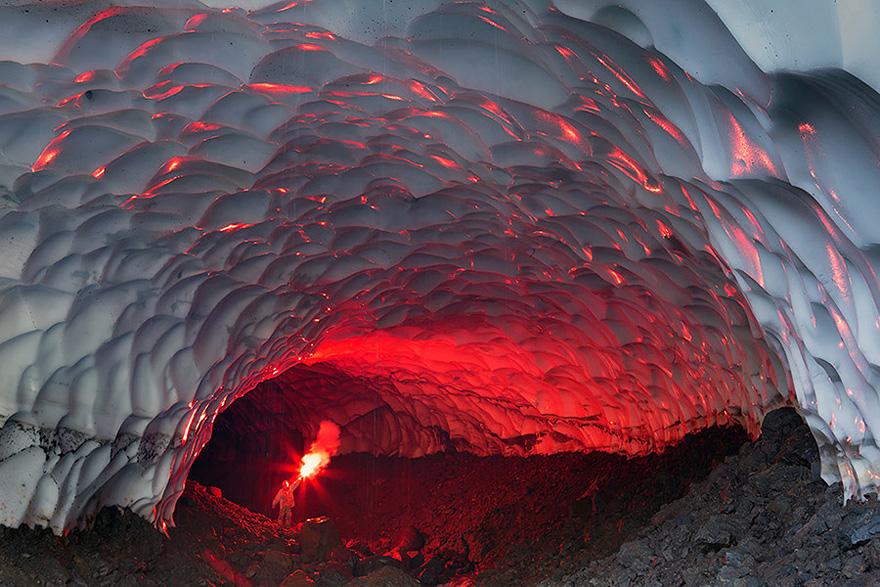
Believe it or not, this amazing, otherworldly Ice Cave is actually real and is situated in Russia, near the Mutnovsky volcano. The half-mile long cave was formed by a stream that flows through glacial fields at the bottom of the volcano. The passage is usually too small to enter, but light snowfall and an unusually hot summer created these massive caverns with a nearly transparent roof, reminiscent of a stained-glass cathedral.

The Naica Mine of the Mexican state of Chihuahua is a working mine that is best known for its extraordinary selenite crystals. Located in Naica in the municipality of Saucillo, the Naica Mine is a lead, zinc and silver mine. Caverns discovered during mining operations contain crystals of selenite (gypsum) as large as 4 feet (1.2 m) in diameter and 50 feet (15 m) long.
The Cave of Crystals (Cueva de los Cristales) is a cave approximately 1,000 feet (300 m) below the surface in the limestone host rock of the mine. The chamber contains giant selenite crystals, some of the largest natural crystals ever found. The selenite crystals were formed by hydrothermal fluids emanating from the magma chambers below. The cavern was discovered while the miners were drilling through the Naica fault, which they were worried would flood the mine.
The Naica Mine Caves are closed to the public. The Cave of Swords is another chamber in the Naica Mine, also containing gypsum crystals but each only about a meter long.

Created by the unparalleled forces of the Vatnajvkull ice cap, the Crystal Cave emerged as a result of its glacier meeting the Icelandic coastline. The cave's ice dates back centuries, and its weight has pressed out all remnant air, so the resultant formation's texture and colors are both brilliant and otherworldly. Access is via a 22-foot entrance at the water's edge, though height clearance tapers down to only about 4 feet at the far end, about 150 feet in.
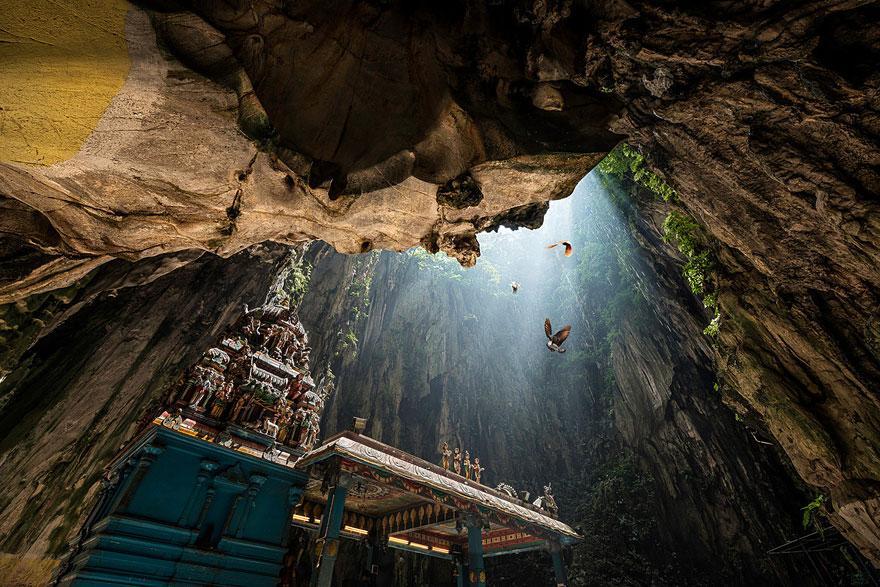
Batu Caves is a limestone hill that has a series of caves and cave temples in the Gombak district, 13 kilometres (8 mi) north of Kuala Lumpur, Malaysia. It takes its name from the Sungai Batu or Batu River, which flows past the hill. Batu Caves is also the name of the nearby village. The cave is one of the most popular Hindu shrines outside India, dedicated to Lord Murugan. It is the focal point of Hindu festival of Thaipusam in Malaysia.
The limestone forming Batu Caves is said to be around 400 million years old. Some of the cave entrances were used as shelters by the indigenous Temuan people (a tribe of Orang Asli). As early as 1860, Chinese settlers began excavating guano for fertilising their vegetable patches. However, they became famous only after the limestone hills were recorded by colonial authorities including Daly and Syers as well as American Naturalist, William Hornaday in 1878.
Batu Caves was promoted as a place of worship by K. Thamboosamy Pillai, an Indian trader. He was inspired by the vel-shaped entrance of the main cave and was inspired to dedicate a temple to Lord Murugan within the caves. In 1890, Pillai, who also founded the Sri Mahamariamman Temple, Kuala Lumpur, installed the "murti" (consecrated statue) of Sri Murugan Swami in what is today known as the Temple Cave. Since 1892, the Thaipusam festival in the Tamil month of Thai (which falls in late January/early February) has been celebrated there.
Wooden steps up to the Temple Cave were built in 1920 and have since been replaced by 272 concrete steps. Of the various cave temples that comprise the site, the largest and best known is the Temple or Cathedral Cave, so named because it houses several Hindu shrines beneath its high vaulted ceiling.
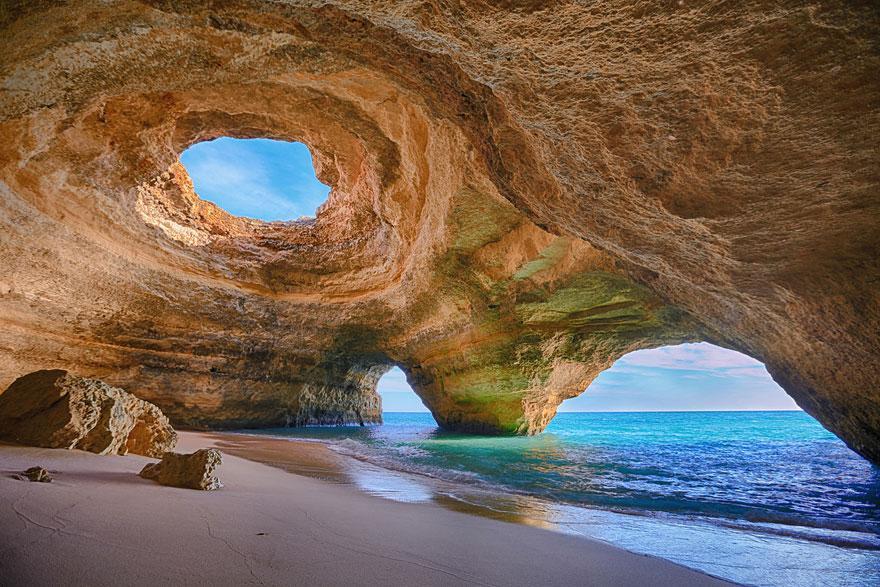
The Algarve region in Portugal, where this cave is located, is prone to various seaside formations because of the rock face's relative solubility in water. This specific cave near Lagos is accessible only by water.
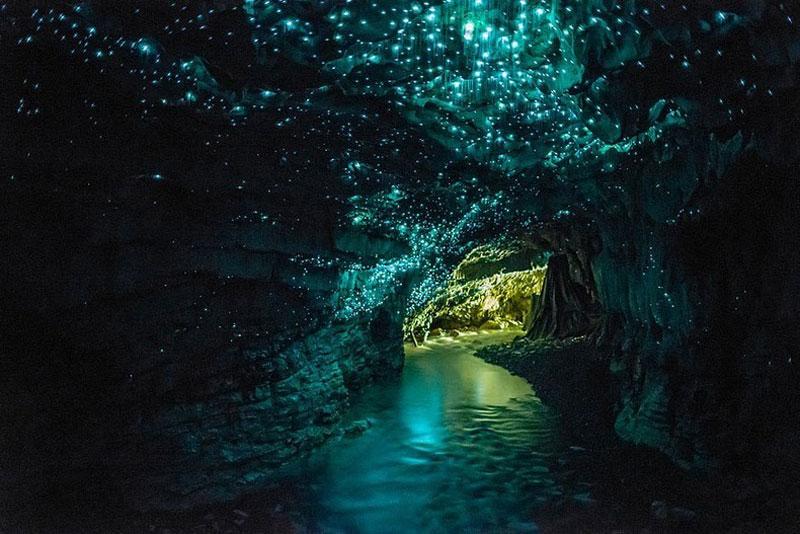
The Waitomo Glowworm Caves attraction is a cave at Waitomo on the North Island of New Zealand, known for its population of glowworms, Arachnocampa luminosa. This species is found exclusively in New Zealand. They are around the size of an average mosquito. This cave is part of the Waitomo Caves system that includes the Ruakuri Cave and the Aranui Cave.
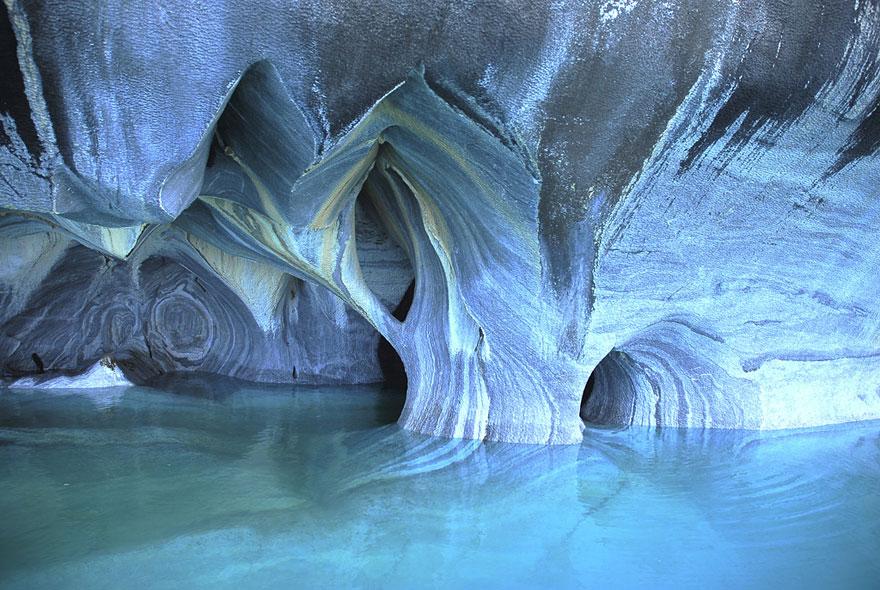
Unusual geological formation is Marble Caves with Marble Chapel and Marble Cathedral located at the centre of the lake and representing a group of caverns, columns and tunnels formed in monoliths of marble.
Marble Caves have been formed by 6,200 years of waves washing up against calcium carbonate, the smooth, swirling blues of the cavern walls are a reflection of the lake's azure waters, which change in intensity and hue, depending on water levels and time of year.

Ellison's Cave is a pit cave located in Walker County, on Pigeon Mountain in the Appalachian Plateaus of Northwest Georgia. It is the 12th deepest cave in the United States and features the deepest, unobstructed underground pitch in the continental US named Fantastic Pit. The cave is over 12 miles long and extends 1063 feet vertically.
Ellison's features a number of underground vertical pitches including the two tallest pits in the continental United States: Fantastic (586 feet) and Incredible (440 feet). These two pits lie on opposite sides of the cave. Nearby and parallel to Fantastic are Smokey I (500 feet), Smokey II (262 feet), and other extremely deep pitches. There are over 7 routes to reach the bottom level of the cave from the Fantastic side. Fantastic and Smokey I both extend to TAG Hall, a passage at the bottom of the cave. To reach Fantastic, or the large pits on the Fantastic side, cavers must also descend the Warm Up pit (125 feet).
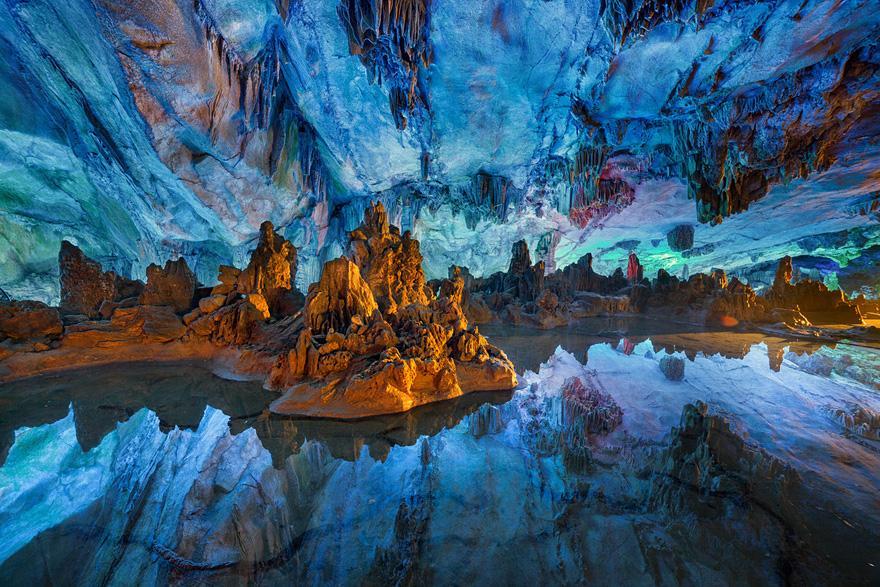
The Reed Flute Cave is a landmark and tourist attraction in Guilin, Guangxi, China. It is a natural limestone cave with multicolored lighting and has been one of Guilin's most interesting attractions for over 1200 years. It is over 180 million years old. The cave got its name from the type of reed growing outside, which can be made into melodious flutes.
Reed Flute Cave is filled with a large number of stalactites, stalagmites and rock formations in weird and wonderful shapes. Inside, there are more than 70 inscriptions written in ink, which can be dated back as far as 792 AD in the Tang Dynasty. These aged inscriptions tell us that it has been an attraction in Guilin since ancient times. It was rediscovered in the 1940s by a group of refugees fleeing the Japanese troops.

